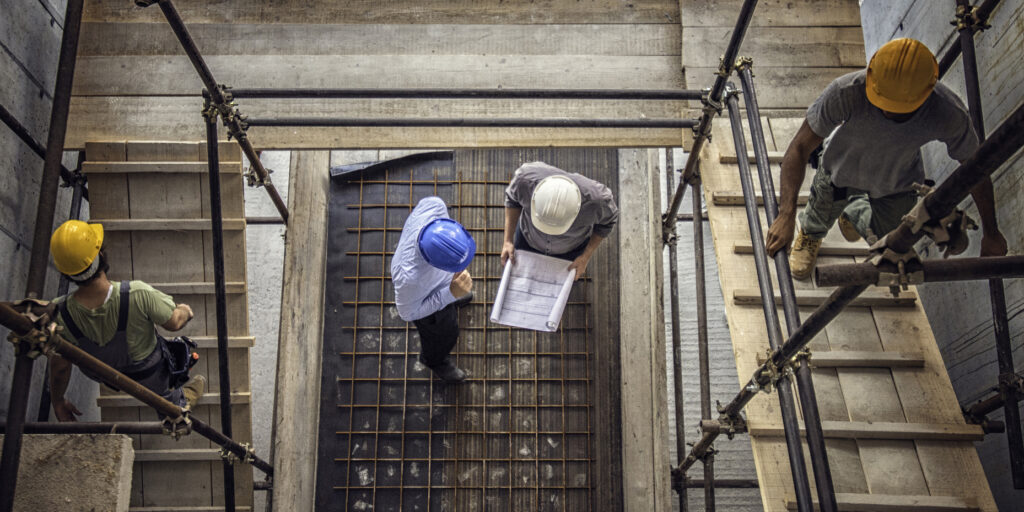— 13 min read
Cost Reporting in Construction: Tracking a Project’s Financial Health


Last Updated May 20, 2025

Ryan O'Donnell
Senior Product Manager, Construction Financials
Ryan O'Donnell works at Procore as Senior Product Manager, Financials. He has spent his career working in construction finance -- including roles as Controller & CFO for Terminal Construction Corporation in NYC, AVP of Commercial Real Estate at M&T Bank, and Senior Auditor for Kiewit Infrastructure Group. Ryan earned his MBA in Accounting & Finance from Rutgers University. He lives in New York.

Taylor Riso
Contributing Writer
91 articles
Taylor Riso is a marketing professional with more than 10 years of experience in the construction industry. Skilled in content development and marketing strategies, she leverages her diverse experience to help professionals in the built environment. She currently resides in Portland, Oregon.
Last Updated May 20, 2025

Knowing a construction project’s financial health can decide its success in an industry where projects are complex and budgets are tight. One of the top methods for attaining a project's financial health is accurate and timely cost reporting.
In this article, we delve into the complexities of cost reporting within the construction industry, examining its fundamental components, the critical role it plays in project management and common challenges that arise.
Table of contents
What is cost reporting?
Cost reporting is the process of record-keeping and analyzing various project expenses — from material and labor costs to equipment and indirect overheads. This practice empowers project managers with the insights to practice effective budget management, aids in forecasting future costs and enables thorough variance analysis.
This level of financial oversight is crucial for making informed decisions: It helps ensure that construction projects meet their operational objectives and adhere to their financial frameworks. Accurate cost reporting is not just a managerial function; it's a method that balances fiscal responsibility with project execution.
Construction Cost Reporting Basics
Cost reporting involves meticulously documenting and analyzing the financial aspects of a construction project, providing insights into the costs that have been incurred and projections of future costs throughout the project’s progress.
At the heart of cost reporting is the dual nature of tracking both the current financial status and the anticipated financial outcome of the construction project. It encompasses a detailed examination of various financial parameters, such as the expenses already incurred, the comparison of these expenses against the projected budget, and an estimation of the total costs expected by the completion of the project. This ongoing process parallels the project's evolution, ensuring that every financial decision is made with a clear understanding of its impact on the project's overall fiscal performance.
Different Types of Costs Tracked in Construction Reporting
Costs in construction are typically categorized into four primary types: direct, indirect, fixed and variable. Each category plays a specific role in the overall financial structure of a construction project.
| Cost Type | Definition | Examples |
| Direct Costs | Expenses directly tied to the physical construction of the project. | Materials (concrete, steel), labor wages for construction workers, equipment rental (cranes, excavators). |
| Indirect Costs | Costs not directly related to physical construction, but necessary for project completion. | Project management fees, administrative expenses, security services and insurance. |
| Fixed Costs | Costs that remain constant throughout the project, irrespective of the project’s scale or duration. | Rent or lease payments for construction equipment such as salaries of permanent staff, licensing fees, office rent. |
| Variable Costs | Costs that change in proportion to the level of construction activity. | Hourly labor wages, fluctuating material costs (due to market prices), fuel for equipment, maintenance costs. |
Keeping tabs on these different cost types allows for more accurate budgeting, cost control and financial planning. Each category impacts the project’s bottom line in different ways, and effective management of these costs is key to maintaining the financial health and success of the construction project.
Elements of Cost Reports
Each element of a cost report plays a specific role in providing a complete big picture of the project's budget and expenditure. Here are the key elements typically included in a cost report:
- Original budget amount: This is the initial budget estimated before the project begins. It serves as the baseline against which all future costs and changes are measured.
- Approved change orders: These are changes approved after the original budget is set, which could be due to modifications in project scope, materials or timeline. They directly affect the project budget and need to be meticulously documented. Change orders account for any increases or decreases that need to be reflected in the projected budget.
- Revised budget: This is an update to the original budget, incorporating the impact of approved change orders. It reflects the current total budgeted cost of the project.
Revised budget = original budget amount + approved change orders
- Pending change orders: These are proposed changes to the contract that are under review but not yet approved. Although not final, they are crucial for forecasting potential budget alterations.
- Projected budget: This number reflects the forecasted revenue for the project.
Projected budget = revised budget amount + pending change orders
- Committed costs: These are costs that the project has already committed to, including purchase orders and subcontracts.
- Direct costs: Costs directly related to the construction work such as labor, materials, and equipment costs.
- Job costs to date: This shows the total costs incurred for the project up to the current date.
- Pending cost changes: These are anticipated cost changes that have not yet been realized or approved but are expected to impact the project budget.
- Projected costs: This includes an estimate of future costs required to complete the project. It's based on the current cost trends and known factors affecting the project's completion.
Projected costs = committed costs + direct costs + pending cost changes
- Forecast to complete: An estimate of the remaining costs needed to finish the project. This forecast is based on current spending patterns and known factors that may influence the project's completion.
- Estimated cost at completion: This provides an overall projection of the total cost of the project upon completion, combining the actual costs to date with the forecasted expenses. It is a critical measure for understanding the final financial commitment required for the project's completion.
- Projected over/under: This shows profitability. The variance indicates whether the project is on track to be financially successful.
Projected over/under = projected budget - estimated cost at completion
Incorporating these elements into a cost report gives construction managers and stakeholders a comprehensive and transparent view of the project's financial health. This detailed reporting is vital for informed decision-making, ensuring that the project remains financially viable and aligns with the set expectations for successful completion.
Further, the level of detail in these reports can be customized according to specific needs. Project managers can choose to analyze financials at a granular level, segmenting cost by the work breakdown structure or scopes within a project, or they can take a broader approach, examining the financials at a project or even portfolio level.
This flexibility allows for tailored analysis and management, ensuring that every aspect of the project's financial performance is monitored and optimized for maximum efficiency and profitability.
Stay updated on what’s happening in construction.
Subscribe to Blueprint, Procore’s free construction newsletter, to get content from industry experts delivered straight to your inbox.

5 Key Aspects of Cost Reporting
Cost reporting in construction is not just about recording expenses — it's a multi-faceted process that encompasses several critical aspects. These components ensure that cost reporting is comprehensive and effective in guiding the financial management of a construction project and maintaining the firm's profitability and fiscal health. Here are the key components of cost reporting.
1. Budgeting: Estimating and Allocating Costs
The foundation of effective cost reporting is a robust budget. This involves estimating the costs that will be incurred and allocating funds accordingly. Budgeting requires a detailed understanding of the scope and the resources needed to bring the project to fruition. It includes forecasting costs for materials, labor, subcontractors, equipment, and indirect expenses. Accurate budgeting sets a baseline against which actual expenditures are measured and serves as the foundation of cost reports.
2. Cost Tracking: Tracking Actual Expenditures
Once the budget is set, the next component of cost reporting is tracking the actual costs as they occur. This process involves meticulously documenting all expenditures, a task that can be accomplished using a variety of methods such as digital software solutions, spreadsheets or traditional manual ledger entries. Cost tracking provides visibility into where the money is being spent and helps identify areas where costs are aligning or deviating from the planned budget.
3. Cost-to-Complete Forecasting: Predicting Future Costs
Cost-to-complete forecasting involves analyzing current spending trends and project progress to predict future expenditures. It helps in understanding the financial trajectory of the project and assists in making informed decisions to keep the project on track financially.
Enhancing this forecasting process, particularly in terms of accuracy and visualization, is where S-curve modeling becomes invaluable. The S-curve, a graphical representation of cumulative costs over time, provides insight into the financial progression of the project. It helps identify when costs will peak and assists in aligning the budget with actual expenditures. By incorporating S-curve modeling, project managers can enhance forecast accuracy, effectively manage resources, and ensure financial alignment throughout the project’s lifecycle.
4. Change Order Management: Handling Changes in Scope
Construction projects often encounter changes that impact the initial cost estimates. Change order management is a critical component of cost reporting and addresses the financial implications of changes in project scope, timeline or materials. Effectively managing change orders ensures that any additional costs are accurately documented, approved and integrated into the overall cost tracking and reporting system.
5. Historical Cost Analysis: Leveraging Past Data for Future Project Success
The analysis of historical costs entails using detailed records of past project expenses to inform and enhance future project estimates and bids. Understanding past costs for different types of work or projects is essentially the lifeblood of a construction company's operational insights.
This method involves a thorough examination of previously incurred costs to serve as a reference point for projecting the financial requirements of upcoming projects. Accurate and detailed historical cost data enables construction companies to make more informed and realistic bids for new projects, increasing their chances of profitability and success.
By analyzing historical costs, companies can identify trends, understand cost drivers and refine their budgeting process for future projects. This approach not only aids in winning new contracts but also ensures that the bids made are financially sound and realistic. In essence, historical cost analysis bridges the gap between past experiences and future opportunities, playing a critical role in strategic decision-making and financial planning within the construction industry.
These aspects of cost reporting provide a holistic approach that is crucial for maintaining financial control and ensuring the profitability and success of construction projects.
Common Challenges with Cost Reporting
Challenges that arise during cost reporting can impact the accuracy and effectiveness of a firm’s financial management, both at the overall business level and on individual projects. Understanding these common challenges, along with strategies to address them, is vital for upholding the integrity and dependability of cost reporting.
Maintaining Data Accuracy & Consistency
A significant challenge in cost reporting is maintaining the accuracy and consistency of data. Errors can arise from different sources, including human error or miscommunication, leading to financial discrepancies. To combat this, firms can implement standardized data entry procedures and leverage automated software systems. Additionally, regular training sessions for staff on the importance of accurate data recording can help minimize errors and improve the overall quality of cost reporting.
Ensuring Data Remains Current
Keeping cost reports updated in real-time is crucial but challenging, especially given the dynamic nature of construction projects. Delays in updating information can result in outdated reports, which adversely affect decision-making. To address this, real-time data entry methods should be adopted and frequent communication between jobsite personnel and firm operations is essential to ensure that cost data is current and relevant.
Managing Change Orders Effectively
Integrating change orders into existing cost reports often requires substantial adjustments to the budget and forecasts. Establishing a clear and structured process for reviewing, approving and documenting these change orders can ensure that the modifications are accurately reflected in the cost reports, maintaining their integrity and usefulness.
Allocating Overhead & Indirect Costs
Allocating overhead and indirect costs across multiple projects is a complicated process. To streamline the process, construction firms can develop a systematic approach for allocating their indirect costs based on fair and logical criteria. This systematic allocation aids in achieving a more accurate representation of project costs.
Precise allocation of these costs is essential not only for ensuring equitable distribution of overheads but also for maintaining the profitability of each project. By accurately attributing indirect costs, firms can better assess the true cost and profit margins of their projects, leading to more informed financial decisions and improved overall financial health of the company.
Accurately Forecasting Future Costs
Predicting future costs accurately is challenging, particularly with market volatility and unforeseen project challenges. To enhance the accuracy of future cost projections, companies should regularly update their forecasts based on the latest project data and market trends. Utilizing predictive analytics tools can also be beneficial in improving the reliability of these forecasts.
Maintaining Cost Coding Accuracy
Ensuring that costs are accurately coded to the correct cost codes is crucial, as the effectiveness of using historical costs for estimating future projects and enhancing profitability hinges on the precise tracking of current costs. For instance, it's essential that all costs associated with concrete are correctly coded to that specific category, and the same precision applies to other scope of work such as electrical. Additionally, it's vital to prevent overhead costs from being inaccurately coded to unrelated operations.
To address this, construction firms can implement a rigorous review process for all costs incurred on a project. This includes a detailed examination of all expenses, from routine Home Depot receipts to comprehensive subcontractor invoices. Involving both accounting staff and project managers in this review process is considered best practice for ensuring accuracy.
Implementing a system of double-checking or multiple verification layers helps to guarantee the correct allocation of all costs to their respective categories or 'buckets.' This approach is key in preserving the accuracy and integrity of cost reporting, and it plays a crucial role in ensuring the reliability of financial data for future project planning and analysis of profitability.
The Use of Technology for Cost Reporting in Construction
Technological advancements have introduced sophisticated tools and software that revolutionize tracking, analyzing and reporting costs. These innovations offer a multitude of benefits that significantly enhance the efficiency and accuracy of cost reporting.
Sophisticated data analysis
Modern cost reporting software is equipped with advanced analytics capabilities, enabling more precise data analysis. This leads to greater accuracy in cost tracking and forecasting, reducing the likelihood of costly errors. With the ability to process large volumes of data quickly, these tools provide a level of accuracy and expediency that manual processes cannot match.
Real-Time Reporting and Accessibility
Technology allows for real-time reporting, which is critical in the fast-paced construction environment. Project managers and stakeholders can access up-to-date financial information anytime, anywhere, facilitating timely and informed decision-making. This immediate access to data ensures that project teams can quickly adapt to changes and manage budgets more effectively.
Streamlining Administrative Processes
The use of software significantly reduces the time and effort required for administrative tasks. Automated data entry, invoice processing, and cost categorization streamline these processes, freeing up valuable time for project teams to focus on other critical aspects of project management.
Enhanced Communication and Collaboration
Technological tools often come with collaborative features that enhance communication among project team members, stakeholders, and clients. This fosters a transparent working environment where all parties are well-informed about the project's financial status, leading to stronger relationships and better project outcomes.
Historical Data Storage and Analysis
Technology facilitates the storage and analysis of historical cost data, which is invaluable for future project estimating and planning. By leveraging past project data, firms can craft more accurate bids, anticipate potential cost overruns and enhance overall project profitability.
Courses about construction.
For construction.
Unlock your career potential with our free educational courses on Health & Safety, Data in Construction, and more.
The Role of Cost Reporting in Construction
Cost reporting in construction serves a dual purpose, functioning both as an internal management tool and as a crucial element in external stakeholder communication. Internally, it's the backbone of financial decision-making, essential for generating financial statements and understanding the overall health of individual projects and the whole company. Although primarily an internal tool, cost reporting is also used by a variety of external stakeholders — such as clients, owners and bonding companies — that require detailed insights into the company's financial handling of specific projects.
Was this article helpful?
Thank you for your submission.
100%
0%
You voted that this article was . Was this a mistake? If so, change your vote
Scroll less, learn more about construction.
Subscribe to The Blueprint, Procore’s construction newsletter, to get content from industry experts delivered straight to your inbox.
By clicking this button, you agree to our Privacy Notice and Terms of Service.
Thank you!
You’re signed up to receive The Blueprint newsletter from Procore. You can unsubscribe at any time.
Categories:
Written by

Ryan O'Donnell
Senior Product Manager, Construction Financials
Ryan O'Donnell works at Procore as Senior Product Manager, Financials. He has spent his career working in construction finance -- including roles as Controller & CFO for Terminal Construction Corporation in NYC, AVP of Commercial Real Estate at M&T Bank, and Senior Auditor for Kiewit Infrastructure Group. Ryan earned his MBA in Accounting & Finance from Rutgers University. He lives in New York.
View profile
Taylor Riso
Contributing Writer
91 articles
Taylor Riso is a marketing professional with more than 10 years of experience in the construction industry. Skilled in content development and marketing strategies, she leverages her diverse experience to help professionals in the built environment. She currently resides in Portland, Oregon.
View profileExplore more helpful resources

Construction Accounting Software: Key Features and What To Look For
Commercial contractors manage large and complicated budgets that can have slow payment rates and volatile costs. They also have to accurately allocate job costs based on specific factors such as...

Construction Collaboration: Navigating the Intersection of Project Management and Accounting
Accounting and project teams work together to move the financial aspects of projects through to completion. Data sharing allows for concurrent review to make this possible. Teams need to share...

What are Committed Costs in Construction Accounting?
In construction projects, managing finances can be a challenging task — but understanding committed costs can simplify the process. Committed costs refer to expenses that are guaranteed through formal agreements,...

Understanding Construction Financial Statements
For construction firms, effectively managing financial statements is an important building block for success. These documents play a key role in tracking performance, maintaining financial health and securing future projects....
Free Tools
Calculators
Use our calculators to estimate the cost of construction materials for your next project.
Templates
Find a template to help you with your construction project tasks.
Material Price Tracker
Get the latest U.S. retail prices and view historical trends for common building materials.
Glossary
Explore key terms and phrases used in the industry.
